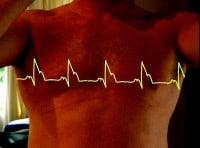
First we tied the world in a tangle of copper cables. Next came miles of fiber optics. And all the time, the ultimate communications conduit was right there, under our noses.
Now the PeopleNet – a global data network using humans as mobile transmission and receiving stations – has driven worldwide connectivity to new heights.
With volunteers getting unlimited free online access 24 hours a day for life, the network of human transmitters, or “humitters”, has mushroomed within two years to hundreds of millions, ranging across every continent. It is now estimated that nearly 88% of the world’s population is online.
Tiny, inexpensive electrodes are either worn on the skin or even better, painlessly implanted. They deliver wireless signals within the body of the host, and to other “humitters” as well as to fixed repeater stations. If the transmission is meant for the host, then super-fast internal connections are made, with humitters accessing the data directly through their own visual cortex.
“This is really cool,” said Jason Britten, a 26-year-old New York copywriter. “I don’t need a device to receive data, and to send it I can use voice and gestures.” Wireless antennae are cleverly disguised as hair extensions, though ‘punk geeks’ prefer shiny spikes protruding from their scalps. “If my battery runs low, I just gulp down an energy drink,” grins Britten.
And the PeopleNet has slashed online costs. “It’s beyond cheap, mainly because each ‘transmission station’ is entirely self-powered,” chuckles Dong Kwan-Moon, one of the South Korean pioneers of the tiny flexible electrodes that can transmit data at a rate of more than a gigabit per second. “And boy, it’s really mobile!”
Business applications are blossoming. Medical monitoring through humitters has become a massive growth industry, slashing the costs of managing personal health. E-commerce in all its forms is booming as the world goes online and millions of new customers and suppliers enter the digital marketplace. A brand-new industry of high-bandwidth super-carriers of confidential corporate, government and scientific data has also developed, with DNA-secure systems to restrict access to authorized users.
“It’s William Gibson’s ‘Neuromancer’ without the dark side,” said a beaming Kwan-Moon in a world-wide media conference, broadcast entirely by means of humitter signals.
ANALYSIS >> SYNTHESIS: How this scenario came to be
Way back in 1791 the Italian scientist Luigi Galvini demonstrated that electricity was the medium whereby nerves pass signals to muscles, when he pumped electrical charges into dead frogs to make their legs twitch. From those humble beginnings, scientists came to realize that life itself was in reality a series of biochemical-electrical reactions.
And so the thought was born – if electrical impulses, then why not data – after all, digital information itself it nothing more than a series of binary electrical signals.
Reality proved much harder than theory, and it was a full two hundred years later when the first breakthroughs in what researchers came to call near-field intra-body communication occurred. In 2007 Japanese scientists were able to open locks and activate other mechanical devices by transmitting signals from electrical devices such as data cards through their bodies.
Plenty of practical problems presented themselves, as New Scientist reported that year: “The body is a poor conductor, so it is hard to make anything but small currents flow through it. Transferring these weak signals is made still more difficult by the fact that current will only flow through a complete circuit…”
But nothing stimulates scientific progress more than a challenge, and in 2010 South Korean scientists develop the first prototype electrodes that overcome resistance and other problems. Wireless acoustic signals travel effectively through water and the body. Implantable devices receive a further boost with the development of silicon-on-silk nano-electronics that are absorbed into the body and connect to the brain. Finally, the power issue is solved by the development of biological fuel cells that access the body’s own glucose reserves.
Commercial applications – from health monitoring to the truly mobile Internet – quickly follow, as people the world over embrace the idea of “human transmitters”, now known everywhere as “humitters.”
Warning: Hazardous thinking at work
Despite appearances to the contrary, Futureworld cannot and does not predict the future. Our Mindbullets scenarios are fictitious and designed purely to explore possible futures, challenge and stimulate strategic thinking. Use these at your own risk. Any reference to actual people, entities or events is entirely allegorical. Copyright Futureworld International Limited. Reproduction or distribution permitted only with recognition of Copyright and the inclusion of this disclaimer.
